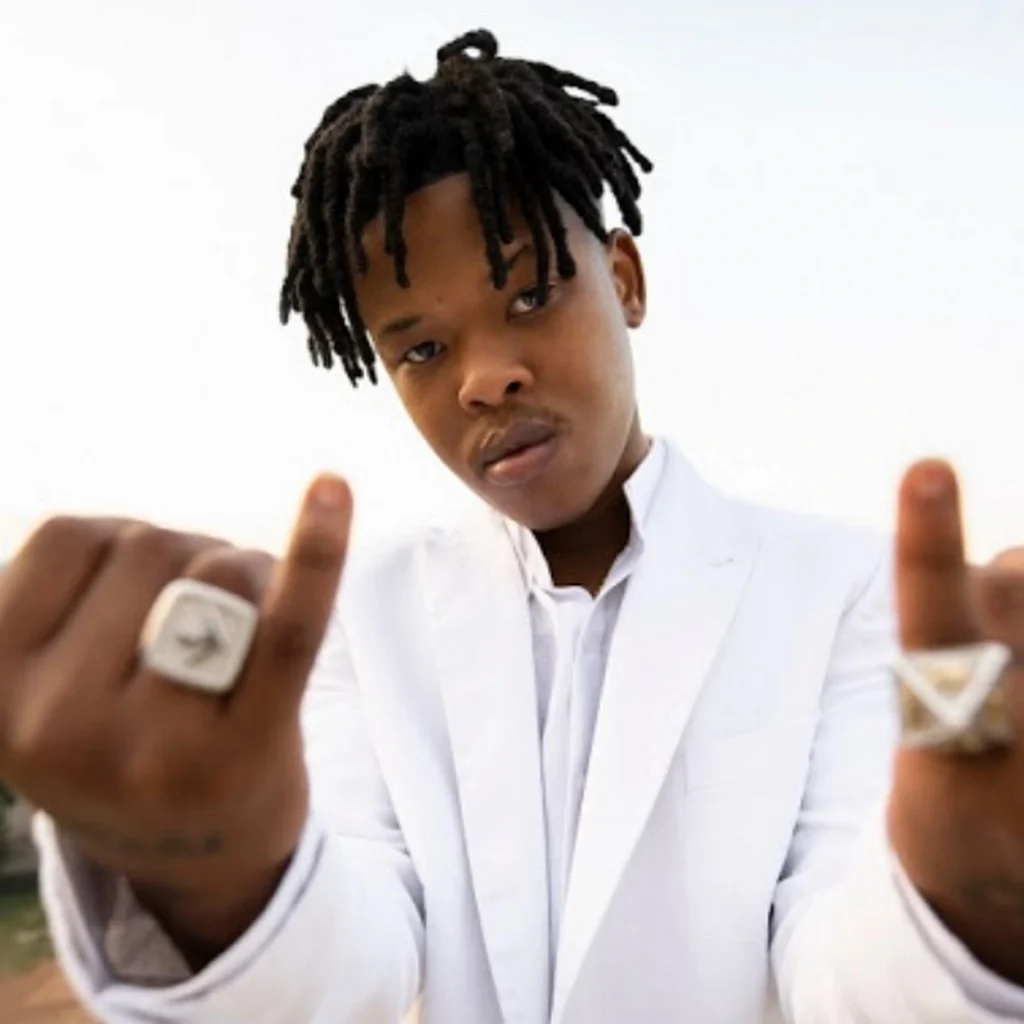Traditional Fashion: Ndebele, Shweshwe, and Swazi Wedding Styles
The Ndebele people, known for their rich cultural heritage, celebrate traditional weddings with distinctive customs and attire. The Ndebele traditional wedding dress is a significant aspect of these celebrations, reflecting the cultural identity and artistic flair of the community. Here’s an overview of the Ndebele traditional wedding dress:
- Colorful and Vibrant Hues:
- Ndebele traditional wedding dresses are renowned for their vibrant and bold colors. The use of bright hues, such as red, yellow, blue, and green, is common. These colors not only symbolize joy and celebration but also showcase the Ndebele people’s love for colorful expressions.
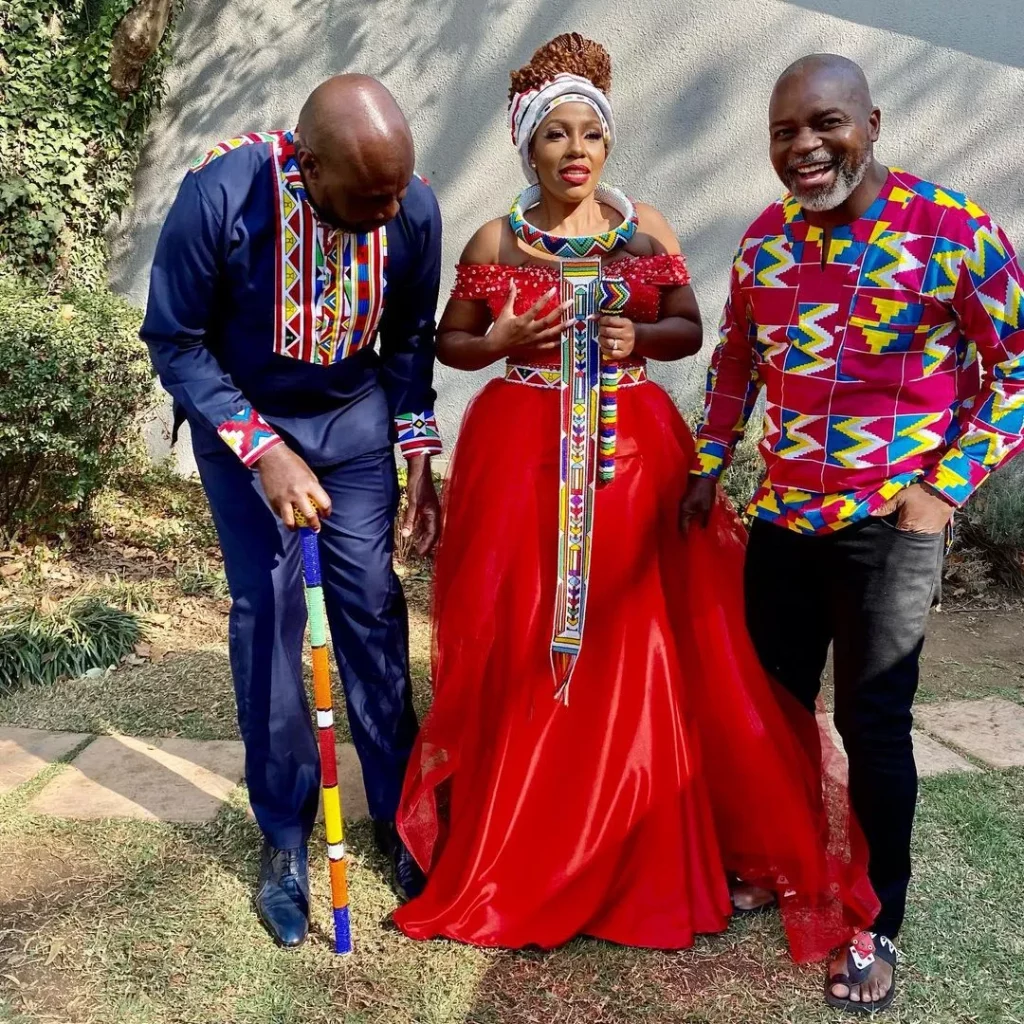
- Beadwork and Patterns:
- Beadwork is a central feature of Ndebele traditional attire. Brides adorn themselves with intricate beadwork that covers various parts of their bodies. The beadwork often forms geometric patterns, symbolic shapes, and cultural motifs, representing the rich artistic heritage of the Ndebele.
- Isicholo (Headpiece):
- The isicholo is a distinctive headpiece worn by Ndebele brides. It is a broad, beaded crown that sits on top of the head. The isicholo is often adorned with colorful beadwork and may feature long tassels or fringes that add to the overall regal appearance.
- Izicolo (Neck Rings):

- Ndebele brides may wear izicolo, which are beaded neck rings. These neck rings are a symbol of beauty and cultural identity. They are often worn in multiples and contribute to the bride’s elegant and dignified look.
- Apron (Idzila or Imbhangi):
- The apron, known as idzila or imbhangi, is a beaded garment worn around the waist. It is an essential part of the Ndebele bride’s ensemble and is adorned with intricate beadwork. The design and colors of the apron carry cultural significance.
- Ibheshu (Skirt):
- The ibheshu is a traditional skirt made of animal skin or fabric. It is worn around the waist and symbolizes the transition from girlhood to womanhood. In contemporary times, fabric skirts are more commonly used.
- Izidliso (Leg Beading):
- Ndebele brides often wear beaded leg adornments known as izidliso. These beaded bands or anklets add a finishing touch to the overall attire.
- Contemporary Adaptations:
- While traditional elements are highly valued, some Ndebele brides may opt for modern adaptations of traditional wedding dresses. Contemporary designs incorporate traditional beadwork and patterns into more modern silhouettes.
The Ndebele traditional wedding dress is a captivating and symbolic representation of cultural pride, artistic expression, and the celebration of love and union within the Ndebele community. Each element of the attire carries cultural significance, making the Ndebele traditional wedding dress a cherished aspect of their heritage.
THE SHWESHWE SOUTH AFRICAN TRADITIONAL WEDDING STYLE
e and highly sought-after variant of the fabric. Brides across the nation are drawn to Shweshwe dresses, with their diverse colors and styles. While Blue, Brown, and Red are the classic and most common choices, the creative exploration of other colors like blue, orange, and mauve by stylists and designers has added a contemporary flair to Shweshwe bridal fashion.
One of the remarkable features of Shweshwe wedding dresses is their versatility in design. These dresses can be tailored to your preferred length and adorned with frills, creating a stunning canvas of colors that captivates the beholder. The intricate designs and vibrant hues of Shweshwe dresses contribute to the bride’s mesmerizing appearance, making her stand out on her special day.
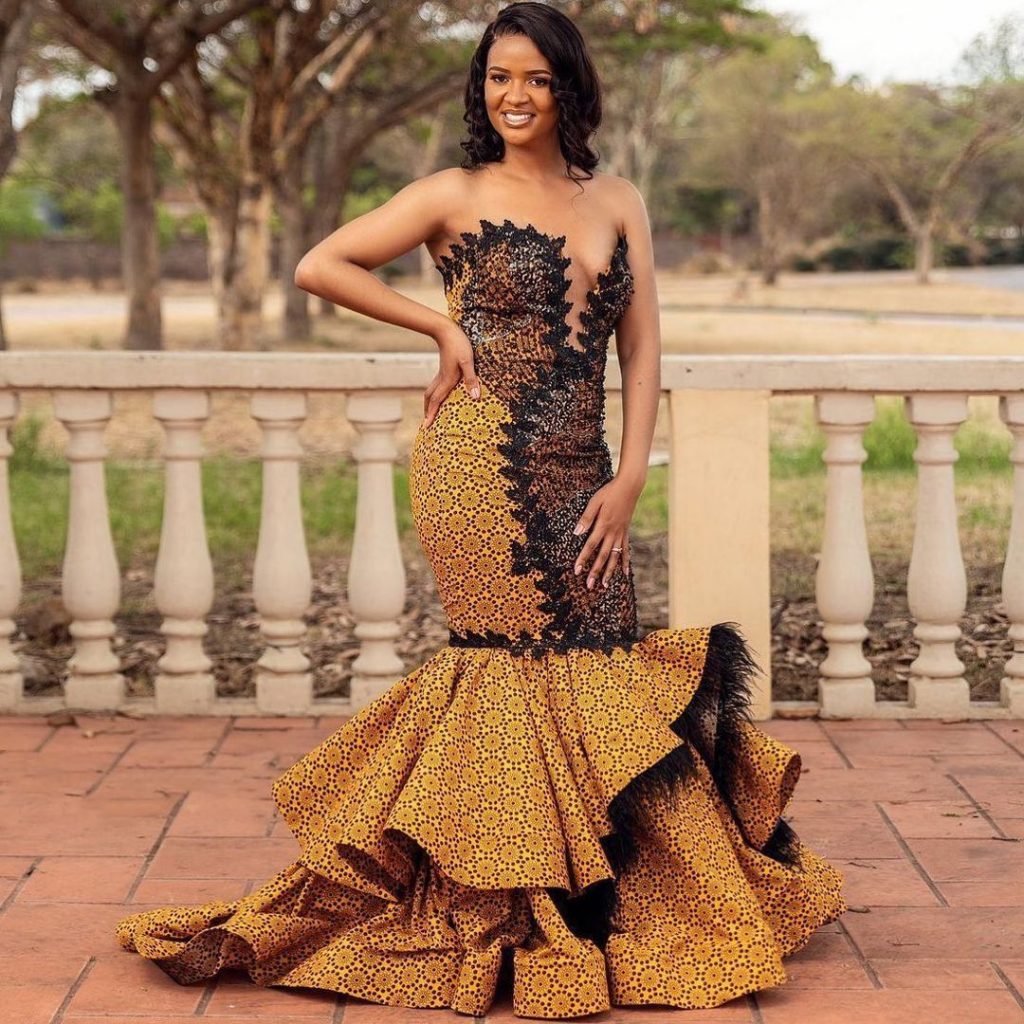
Shweshwe designs have transcended mere fashion trends; they have become an integral part of the daily wardrobe for many African-American women, symbolizing both style and cultural heritage. This unique fabric is not just limited to everyday wear; it has found its place as a cherished wedding attire, embodying the fusion of contemporary elegance and historical significance.

The enduring appeal of Shweshwe is further accentuated by the evolving colors and patterns that continue to captivate fashion enthusiasts. Whether worn during a wedding ceremony or another significant event in South Africa, Shweshwe adds a touch of cultural richness and sartorial excellence. Its presence in these important life moments speaks to its cultural significance and the pride with which individuals embrace their heritage through fashion. Shweshwe is not just a fabric; it is a celebration of tradition, style, and the timeless beauty of African craftsmanship.
TRADITIONAL WEDDING STYLE IN SWAZILAND SOUTH AFRICA
The Swazi people, known for their rich cultural heritage, celebrate weddings with unique customs and attire. The Swazi traditional wedding dress is a significant aspect of these celebrations, reflecting the cultural identity and regal elegance of the community. Here’s an overview of the Swazi traditional wedding dress:
- Emahiya (Traditional Attire):
- The emahiya is a traditional Swazi garment worn by brides. It is a voluminous and colorful fabric that is draped over the body. The emahiya is often adorned with intricate beadwork, embroidery, and symbolic patterns.
- Siswiba (Beaded Necklaces):
- Swazi brides adorn themselves with siswiba, which are beaded necklaces. These necklaces are crafted with vibrant beads and may vary in length and design. Siswiba serves as a symbol of beauty and cultural identity.
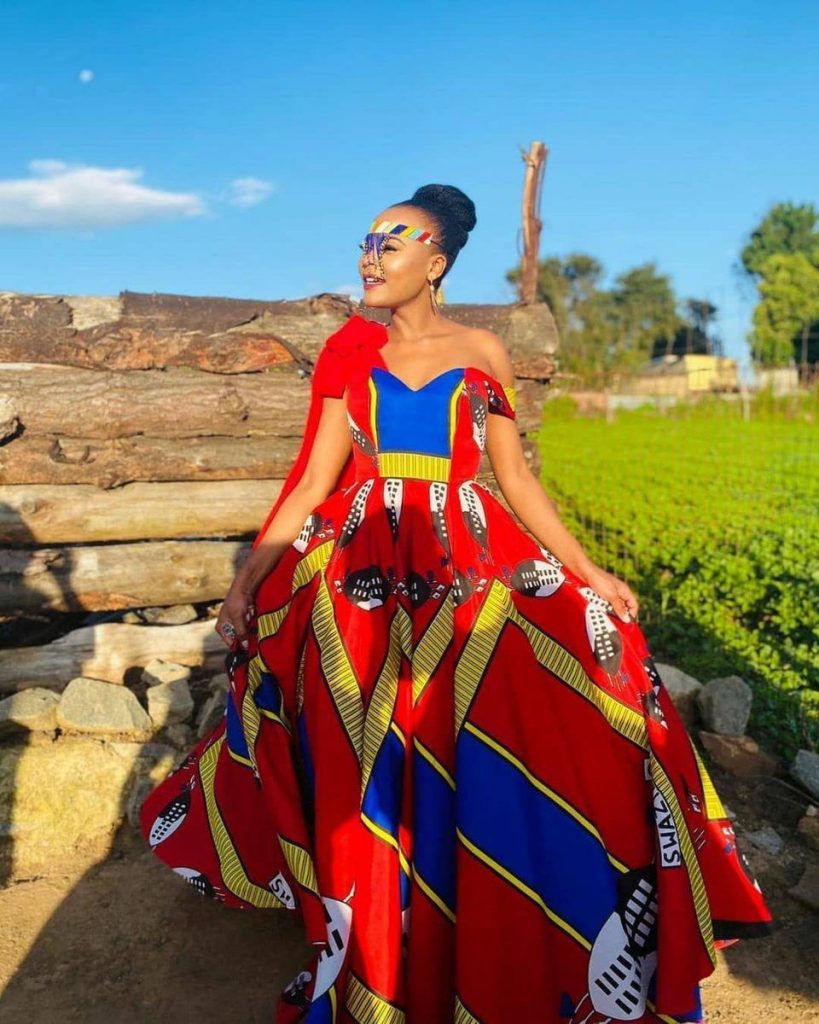
- Lidzimba (Beaded Bodice):
- The lidzimba is a beaded bodice worn by Swazi brides. It is intricately crafted with beads and may feature traditional patterns and symbols. The beadwork on the lidzimba is a central element of the bride’s attire.
- Emahiya Lomdzala (Head Wrap):
- The emahiya lomdzala is a head wrap worn by Swazi brides. It is crafted from the same fabric as the emahiya and is elegantly tied around the head. The head wrap completes the bride’s overall look.
- Emahiya Lomgcobo (Shawl of Dignity):
- The emahiya lomgcobo is a shawl worn by Swazi brides, often in a different color or pattern. It is draped over the shoulders and adds a touch of dignity to the bride’s ensemble. The shawl may be embellished with beadwork.
- Tinkhamba (Beaded Anklets):
- Tinkhamba refers to beaded anklets worn by Swazi brides. These anklets are adorned with colorful beads and add a traditional and cultural touch to the bride’s feet.
- Ligcebesha (Beaded Bracelets):
- Swazi brides wear beaded bracelets, known as ligcebesha, on their wrists. These bracelets are crafted with intricate beadwork and contribute to the overall beauty of the bride’s hands.
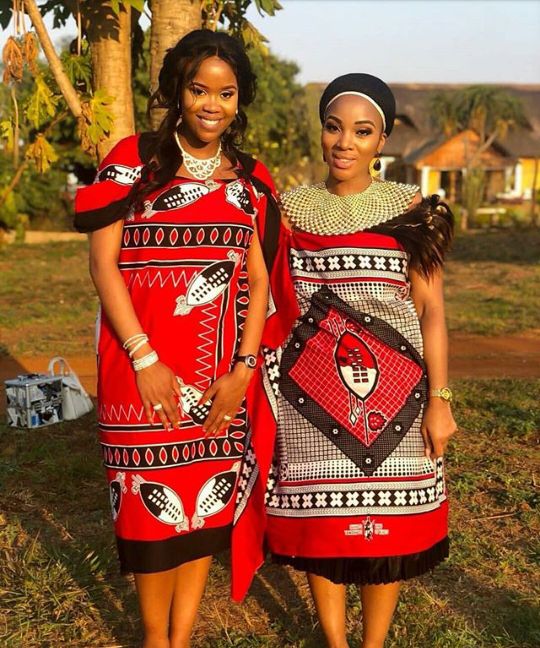
- Contemporary Influences:
- While traditional elements are highly valued, some Swazi brides may incorporate contemporary influences into their wedding attire. Modern designs may blend traditional beadwork with contemporary silhouettes.
The Swazi traditional wedding dress is a stunning representation of cultural pride, artistic expression, and the celebration of love within the Swazi community. Each element of the attire carries cultural significance, making the Swazi traditional wedding dress a cherished and meaningful expression of their heritage.

